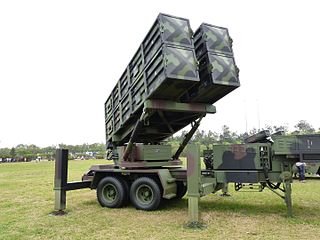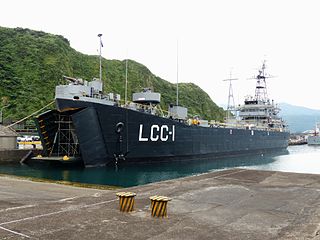
The Kidd-class destroyers were a series of four guided-missile destroyers (DDGs) based on the Spruance class. In contrast to their predecessor's focus on anti-submarine warfare, the Kidds were designed as more advanced multipurpose ships with the addition of considerably enhanced anti-aircraft capabilities. Originally ordered for the former Imperial Iranian Navy, the contracts were canceled when the 1979 Iranian Revolution began, and the ships were completed for the United States Navy. They were decommissioned in 1999 and sold to the Republic of China Navy as the Kee Lung class.

The Republic of China Navy, also called the ROC Navy and retroactively as the Chinese Navy but colloquially as the Taiwan Navy, is the maritime branch of the Republic of China Armed Forces (ROCAF).

The Coast Guard Administration of the Ocean Affairs Council, also known as the Taiwan Coast Guard or R.O.C. Coast Guard, is charged with maintaining law and order, protecting the resources of the territorial waters of the Republic of China (Taiwan), which surrounds Taiwan, Penghu, Kinmen, Matsu Islands, Green Island, Orchid Island, Pratas Island (Tungsha/Dongsha), and Nansha Islands as well as providing a first line of defense along coastal areas against smugglers and illegal immigrants. The CGA is considered a civilian law enforcement agency under the administration of the Ocean Affairs Council of the Executive Yuan, though during emergencies it may be incorporated as part of the Republic of China Armed Forces.

The Hsiung Feng II is an anti-ship missile system developed by the National Chung-Shan Institute of Science and Technology (NCSIST) in Taiwan. The HF-2 is designed to be deployed aboard ships or at facilities on land. An airborne version has also been developed which can be carried by the ROC Air Force's F-CK fighters. The HF-2 has ECCM capabilities and is deployed on the ROC Navy's Cheng Kung-class and La Fayette-class frigates, as well as at several land-based sites. In 2000, plans were announced to replace the HF-2 missiles stationed on the Cheng Kung frigates with the RGM-84 Harpoon, but the budget for this was cancelled.

National Chung-Shan Institute of Science and Technology is a Taiwanese state owned corporation, formerly part of the Republic of China Ministry of National Defense's Armaments Bureau, which is active in the development, manufacturing, support, and sustainment of various weapons systems and dual use technologies.

The Cheng Kung-class frigates are eight guided-missile frigates in service in the Republic of China Navy (ROCN). They are based upon the U.S. Oliver Hazard Perry class and built by China Shipbuilding Corporation in Kaohsiung, Taiwan under license throughout the 1990s as part of the Kuang Hua I project. These frigates served as the mainstay of the ROCN's area air defense capability prior to the acquisition of the Keelung (Kidd)-class destroyers in 2005. They are designated with the hull classification PFG rather than FFG used by the Oliver Hazard Perry class.
CSBC Corporation, Taiwan is a company that produces ships for civilian and military use in Taiwan. It is headquartered in Kaohsiung, with shipyards in Kaohsiung and Keelung. It was a state-owned enterprise before privatization via an IPO in 2008.

USS Dukes County (LST-735) was an LST-542-class tank landing ship built for the United States Navy during World War II. Named after Dukes County, Massachusetts, she was the only U.S. Naval vessel to bear the name. In 1957 she was decommissioned and leased to the Republic of China. In 1962 she was commissioned into Republic of China Navy service.

The Kuang Hua VI-class missile boat is a type of missile boat in service with the Republic of China Navy (ROCN). The prototype was launched in 2003, and the boat first entered service by 2010.

The Tuo Chiang-class corvette is a Taiwanese-designed class of fast and stealthy multi-mission corvettes built for the Republic of China (Taiwan) Navy. It is designed to counter the numerous and increasingly sophisticated People's Liberation Army Navy ships by utilizing hit-and-run tactics, and thus features clean upper structure design with very few extrusions to reduce radar signature, pre-cooled engine exhaust to reduce infrared signature, and a reduced visual signature to reduce chance of detection.

Jong Shyn Shipbuilding Company (JSSC) is a Taiwanese shipbuilder based in Kaohsiung, Taiwan. It is the largest private shipbuilder in Taiwan.

Lungteh Shipbuilding is a Taiwanese ship and boat builder headquartered in Yilan County.
The Ship Ocean Industries Research and Development Center is a Taiwanese government owned naval architecture and maritime research institute founded in 1976.

The Ching Chiang class is a class of patrol ships/corvettes built by CSBC for the Republic of China Navy.

The defense industry of Taiwan is a strategically important sector and a significant employer. They primarily supply weapons and platforms to the Republic of China Armed Forces with few major weapons systems exported abroad. With foreign assistance the Taiwanese defense industry has produced fighter aircraft, missile systems, surface ships, radars, rocket artillery, armored vehicles, and small arms.

The Anping class is a class of offshore patrol vessels manufactured by Jong Shyn Shipbuilding Company for the Coast Guard Administration of Taiwan.

The Chiayi-class patrol vessel is a heavy patrol vessel of the Coast Guard Administration of Taiwan. Four ships are planned. All four are planned to be constructed by CSBC Corporation, Taiwan.

The Yushan-class landing platform dock is a class of landing platform dock built by CSBC Corporation, Taiwan for the Republic of China Navy (ROCN). Four ships are planned, with one ship launched in April 2021.

The Hai Kun-class submarine, alternatively known as the Indigenous Defense Submarine (IDS) program, is a class of attack submarines built by CSBC Corporation, Taiwan for the Republic of China Navy. While the Hai Kun class is thought to be based on the Dutch Zwaardvis class, which is currently operated by Taiwan, the design has been brought up to date by incorporating many new and more modern systems.
![12.15 Zong Tong Chu Xi [Gao Xiao Neng Jian Ting Hou Xu Jian Shou Jian Ming Ming , Xia Shui Ji Kuai Su Bu Lei Ting Shou Ting Jiao Ting Dian Li ] - 50721841919.jpg](http://upload.wikimedia.org/wikipedia/commons/thumb/0/0d/12.15_%E7%B8%BD%E7%B5%B1%E5%87%BA%E5%B8%AD%E3%80%8C%E9%AB%98%E6%95%88%E8%83%BD%E8%89%A6%E8%89%87%E5%BE%8C%E7%BA%8C%E8%89%A6%E9%A6%96%E8%89%A6%E5%91%BD%E5%90%8D%E3%80%81%E4%B8%8B%E6%B0%B4%E6%9A%A8%E5%BF%AB%E9%80%9F%E5%B8%83%E9%9B%B7%E8%89%87%E9%A6%96%E8%89%87%E4%BA%A4%E8%89%87%E5%85%B8%E7%A6%AE%E3%80%8D-_50721841919.jpg/300px-12.15_%E7%B8%BD%E7%B5%B1%E5%87%BA%E5%B8%AD%E3%80%8C%E9%AB%98%E6%95%88%E8%83%BD%E8%89%A6%E8%89%87%E5%BE%8C%E7%BA%8C%E8%89%A6%E9%A6%96%E8%89%A6%E5%91%BD%E5%90%8D%E3%80%81%E4%B8%8B%E6%B0%B4%E6%9A%A8%E5%BF%AB%E9%80%9F%E5%B8%83%E9%9B%B7%E8%89%87%E9%A6%96%E8%89%87%E4%BA%A4%E8%89%87%E5%85%B8%E7%A6%AE%E3%80%8D-_50721841919.jpg)
















